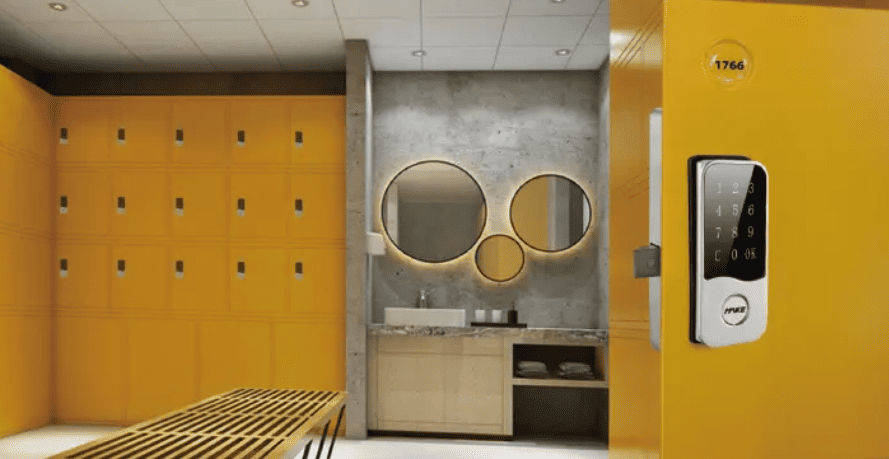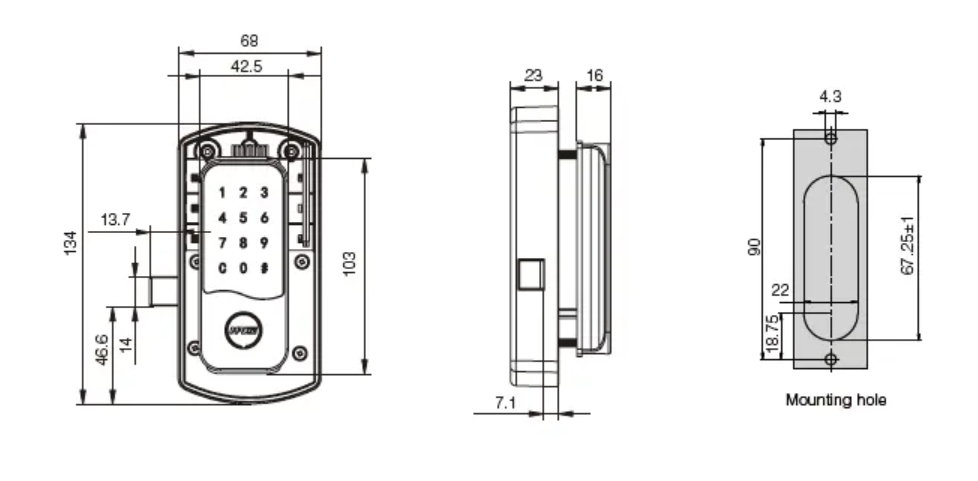In today’s fast-paced world, convenience and security go hand in hand, especially when it comes to safeguarding our personal belongings and controlling access to secure areas. Traditional lock-and-key systems, while still common, have notable limitations such as the risk of lost keys, unauthorized copying, and the hassle of managing multiple keys in shared spaces. Enter the keypad locker lock — a modern, keyless solution that uses digital technology to unlock doors, lockers, and compartments through a simple numerical code.
Keypad locker locks are revolutionizing access control in homes, offices, gyms, schools, and numerous commercial environments. By replacing physical keys with user-defined PINs (Personal Identification Numbers), these locks provide greater security, flexibility, and ease of use. This article explores everything you need to know about keypad locker locks, from their working principles to their advantages, safety concerns, battery requirements, and how to choose the right type for your needs.

A keypad lock is a locking mechanism that integrates a numeric keypad on the device. Instead of a physical key, users enter a PIN or code on this keypad to unlock the mechanism. When the correct code is input, the lock disengages, granting access to the secured area or locker.
Unlike traditional mechanical locks, keypad locks eliminate the risk of lost or stolen keys. They offer keyless entry and can be programmed with multiple codes, making them ideal for shared use environments. In many cases, keypad locks also allow administrators to change codes easily, enabling temporary access for guests or employees without compromising overall security.
Keypad locks come in various types, including standalone models that require no wiring and smart locks that connect to broader security systems for enhanced functionality. Their widespread adoption is driven by the need for improved security and the convenience of digital access control.
Before adopting keypad locker locks for your home, office, or facility, it’s essential to understand the benefits they bring. Here are the primary advantages:
Keypad locker locks remove the need for carrying physical keys. Forgetting or misplacing keys is a common annoyance that keypad locks solve. With a quick and easy PIN entry, users save time and reduce the frustration of being locked out.
This feature is particularly useful for families with children, gyms with frequent locker users, or workplaces with multiple employees needing access. The lock’s intuitive operation means even children or elderly users can operate them without difficulty.
Many people worry whether keypad locks are as secure as traditional locks. In reality, the absence of a keyhole means these locks are resistant to traditional lock-picking techniques. The security strength largely depends on the code complexity—codes typically range from 4 to 6 digits, making random guessing highly improbable.
Furthermore, many keypad locks come with anti-tampering features such as lockout periods after multiple incorrect attempts or alarms triggered by forced entry. This discourages potential intruders and protects your valuables.
Although initial costs for digital keypad locks can be higher than traditional locks, the investment pays off in the long run. Properties equipped with advanced access control systems are increasingly attractive in the real estate market, often commanding higher resale values. The convenience, flexibility, and modern appeal also improve user satisfaction in commercial settings.

When it comes to choosing a lock, safety is one of the most important factors to consider. Fortunately, keypad locker locks are generally regarded as very safe, thanks to their innovative design and technology. One key feature that enhances their security is the absence of a traditional keyhole, which eliminates vulnerabilities associated with lock picking or bumping — common methods burglars use to gain unauthorized entry.
In addition, keypad locks rely on digital passcodes, often requiring a 4 to 6-digit PIN, which significantly reduces the chances of guessing the correct code. More advanced models may even incorporate multi-factor authentication, adding an extra layer of protection by combining PIN entry with biometric verification or mobile app access.
While there is a theoretical possibility of electronic keypad locks being hacked, such incidents are extremely rare. Most intruders prefer to target properties with less sophisticated security systems because keypad locks present a more challenging obstacle.
However, user behavior also plays a crucial role in maintaining security. Regularly changing access codes and refraining from sharing them indiscriminately are important practices to keep your keypad lock safe.
Yes, most keypad locker locks rely on batteries to power their electronic components and enable keyless entry. The type and quality of batteries used can vary depending on the lock’s model and manufacturer, which influences battery life and overall performance.
Many keypad locks use lithium batteries due to their long-lasting nature and reliability. These batteries can power a lock for several months or even years before needing replacement, making them a popular choice for users seeking low-maintenance security solutions.
On the other hand, some keypad locks run on alkaline batteries, which are more widely available and easier to replace. However, alkaline batteries typically have a shorter lifespan compared to lithium, requiring more frequent changes to keep the lock functioning smoothly.
To help users avoid unexpected lockouts caused by dead batteries, modern keypad locker locks often come equipped with battery life indicators or low battery warning alerts. These features notify users well in advance when it’s time to replace the batteries, ensuring uninterrupted access.
Additionally, many electronic keypad locks include backup options such as a physical key override or external power inputs, allowing entry even if the battery dies completely. This added functionality offers peace of mind and prevents lockouts in emergencies.
Because keypad locks depend on batteries, it’s essential to regularly check the power status and replace batteries proactively. Doing so maintains optimal lock performance and security without unexpected interruptions.
Not all keypad locks are created equal. Selecting the ideal keyless lock depends on your specific needs, the environment in which it will be used, and your security expectations. Here are the three main categories of keypad locks to consider:
No Maintenance: These battery-free locks rely purely on mechanical dials or rotating number discs. Once installed, they require no power source or maintenance.
Non-Destructive Access: If users forget the code, specialized override tools or master keys allow non-invasive resetting or access without damaging the lock.
Budget-Friendly: Mechanical combination locks are generally less expensive than electronic counterparts.
Reliability: Their straightforward design makes them highly reliable in harsh environments without risk of electronic failure.
Mechanical keypad locks are ideal for simple access control where no advanced features or remote management are required.
Wire-Free Installation: Most electronic keypad locks are battery-operated, allowing flexible placement without wiring.
Multiple Access Options: Besides keypad entry, some models support RFID cards, mobile app access, or biometric integration.
Flexible Usage Modes: Locks can be set for assigned users (employees with permanent codes) or shared users (temporary guests).
Simplified Management: Codes and access rights can be programmed and updated on-site, often via electronic keys or tablet software, reducing the need for lock core replacement if keys are lost.
Audit Trails: Some electronic locks provide logs showing who accessed the lock and when, improving accountability.
Electronic locks are suitable for medium to large facilities that benefit from flexible user management and enhanced security features.
Wire-Free or Hardwired: Smart locks come in wireless (battery-powered) or wired versions, depending on infrastructure requirements.
Integration with Security Systems: These locks integrate seamlessly with building-wide security and automation systems, offering centralized control.
Detailed Monitoring: Advanced audit trails track usage patterns, access times, and frequency.
Remote Management: Smart locks can be managed remotely using cloud-based software or smartphone apps, enabling instant access permission changes or lock status monitoring.
Real-Time Alerts: Receive instant notifications about lock activity or attempted breaches, improving real-time security response.
Smart locks are the best choice for tech-savvy users and businesses wanting maximum control and security through digital platforms.
Keypad locker locks are highly versatile and can be used in various contexts:
Residential Use: Front doors, home offices, personal safes, and garden gates.
Workplaces: Employee lockers, server rooms, restricted access areas.
Fitness Centers: Gym lockers, poolside changing rooms.
Educational Institutions: Student lockers, lab storage, faculty offices.
Hotels and Hospitality: Guest room lockers, back-of-house storage.
Public Facilities: Airports, train stations, libraries with shared lockers.
The flexibility of programming multiple codes and changing access permissions quickly makes keypad locks ideal for high-traffic, shared-access environments.
For optimal security, consider professional installation, especially for electronic or smart locks requiring integration.
Change access codes periodically and immediately after a user leaves to prevent unauthorized entry.
Monitor battery levels regularly and replace batteries before they run out.
For smart locks, keep firmware updated to protect against vulnerabilities and enhance features.
Maintain backup override options, such as physical keys or master codes, to prevent lockouts.
As technology advances, keypad locker locks continue evolving with trends like:
Biometric Integration: Combining keypad entry with fingerprint or facial recognition for multi-factor authentication.
AI-Powered Security: Using AI to detect unusual access patterns and proactively alert security personnel.
Energy Efficiency: Developing longer-lasting batteries and energy harvesting methods to reduce maintenance.
Voice Control: Integrating voice assistants for hands-free operation.
Sustainability: Using eco-friendly materials and recyclable components.
Keypad locker locks represent a smart, secure, and convenient evolution in access control technology. Whether you’re upgrading your home’s security, managing a busy gym, or controlling access to commercial facilities, these locks offer flexible solutions tailored to your needs.
By eliminating the risks associated with physical keys and offering multiple management options, keypad locker locks enhance security while simplifying access for authorized users. From simple mechanical combination locks to advanced smart systems with remote management, there is a keypad lock solution for every setting.
Embrace the future of secure access control with MAKE’s keypad locker locks — where convenience meets peace of mind.
